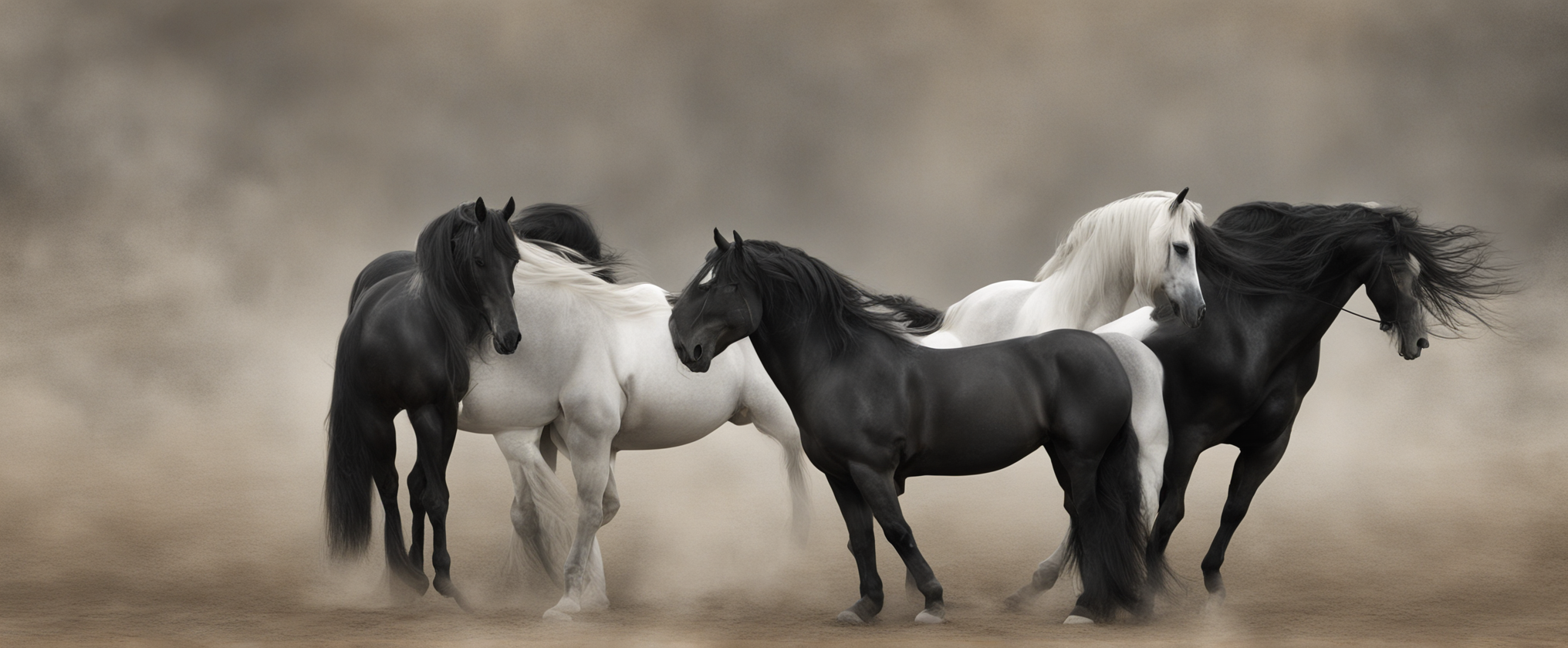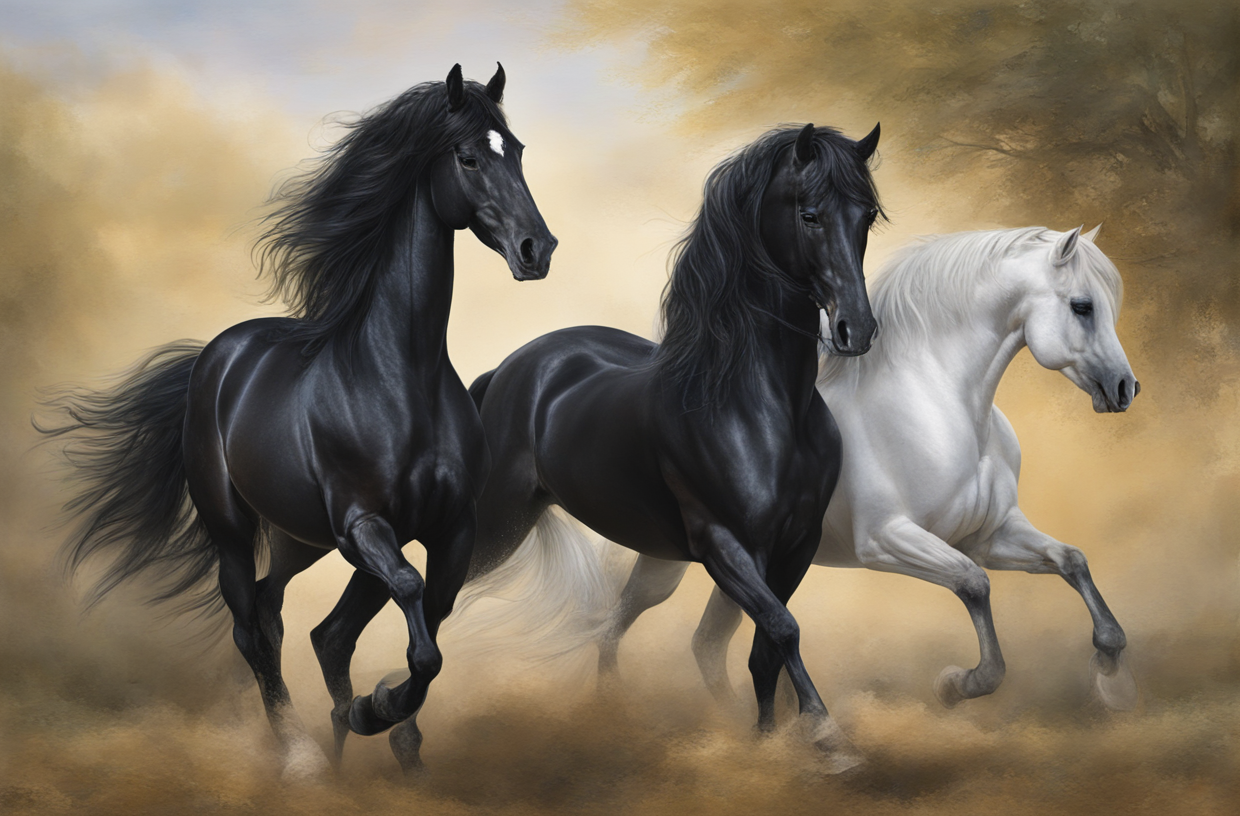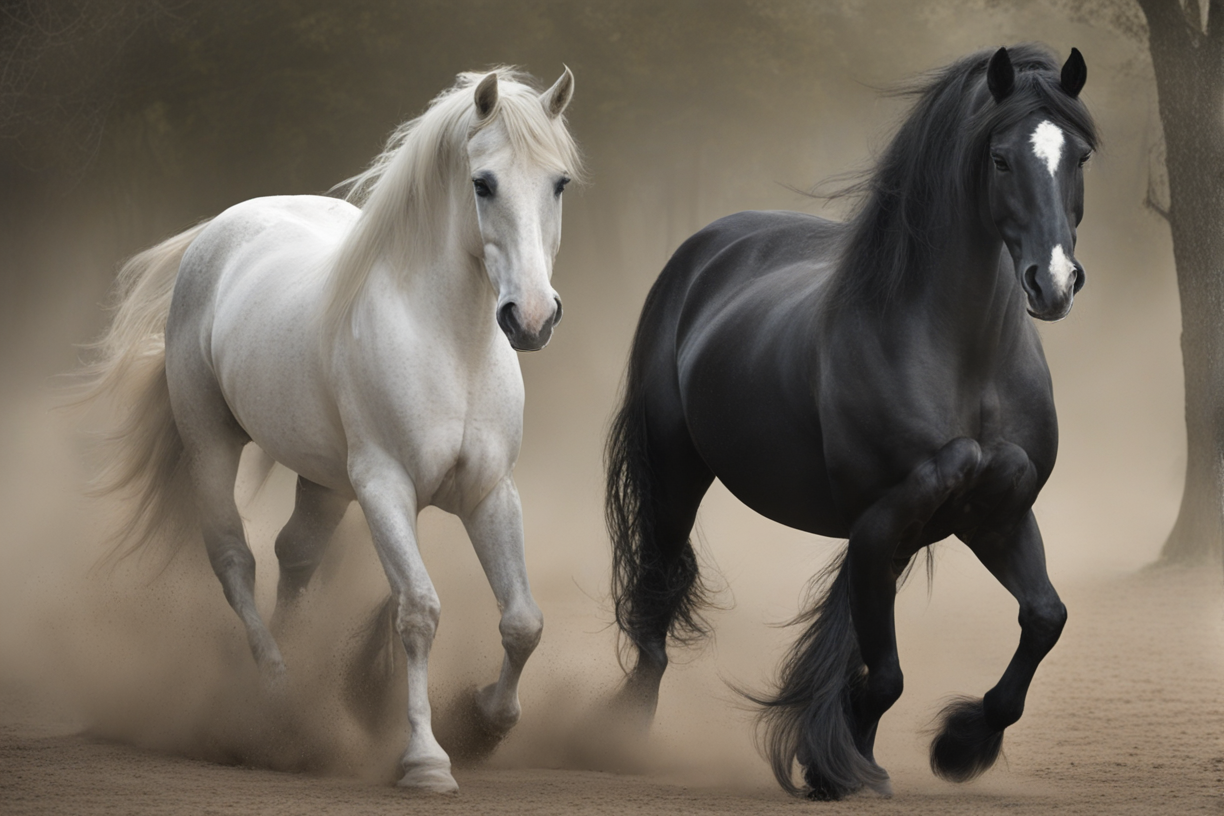Jack here, and today I want to tackle the age-old debate between two of the most iconic horse breeds – Friesians and Andalusians.
I’ve had personal experience with both, so I’m gonna give you my take on their biggest differences and similarities to help you decide which might be the best fit for you.
Now I ain’t no professional horse trainer, but I grew up on my grandpa’s farm where he bred gorgeous Friesians.
I was basically raised in the saddle on those gentle giants.
Then when I was a teen I spent a summer working at a dude ranch that had mainly Andalusians.
So while I’m far from an expert, I know a thing or two about these majestic breeds.
First, let’s talk about their origins.
Friesians were originally bred as war horses in the Netherlands province of Friesland. Even today, they remain a symbol of Dutch pride.
Andalusians come from the Iberian peninsula and were bred by European knights for battle. So both have a history of being strong, sturdy riding horses.
Table of Contents
Size & Appearance
Now for the fun stuff – how do they stack up aesthetically? Well, both breeds are known for having long, wavy manes and tails. But there are some key differences:

Friesians tend to be a bit stockier and heavier. Most range from 1400-2000 pounds and stand between 15-17 hands high.
They nearly always have jet black coats, unless they have a rare genetic disease. Their facial profile is quite straight.
Andalusians are a bit more finely built and agile.
They range from 900-1500 pounds and stand 15-16 hands high typically. Their coat colors can vary from grey to bay to black. They have a very pronounced facial profile with a strongly arched forehead.
Temperament
When it comes to personality, here’s the scoop:

Friesians are known as gentle giants. They tend to be extremely sweet-natured and eager to please. This makes them great for first-time owners or timid riders. They are very affectionate and love spending time with “their people.”
Andalusians are a bit more spirited and energetic. They are super smart and athletic, often excelling at dressage and other technical disciplines. They bond closely with their person but may be wary of strangers. Early socialization is key for this breed.
Care & Health
Both breeds require regular hoof care and grooming to keep their manes and tails looking fabulous. Here are some other key considerations:

- Friesians need LOTS of food due to their size – plan on 2-3% of their body weight per day!
- Andalusians are prone to immune disorders, so talk to your vet about preventative care.
- Monitor both breeds for metabolic issues like insulin resistance and laminitis.
- Provide plenty of turnout and exercise daily to prevent colic and other issues.
Riding Style & Uses
So what can you do with these amazing breeds?
Friesians excel at dressage, combined driving, and pleasure riding. Their steady temperament makes them great therapy horses too.

Andalusians love fast-paced pursuits like jumping, gaming, and cattle work. Their sensitivity also allows them to be successful in classical dressage.
Both breeds make fantastic mounts for parades, ceremonies, and other events where their beauty can be appreciated!
Origins & History
The Friesian horse breed originated in the Dutch province of Friesland, where they were valued for their ability to carry knights into battle.
In the Middle Ages, their size and strength made them ideal as war horses. They were also used to work the lands of local farmers. Today, Friesians remain a cultural icon in the Netherlands, featured in parades and ceremonies. But now they are bred mostly for riding and driving.
The Andalusian horse emerged on the Iberian peninsula, bred by Spanish knights and nobility. Their agility and stamina allowed them to excel as cavalry horses.
For centuries in Spain, only the nobility could own pure Andalusians. The Carthusian monks also helped preserve and refine the breed at their monastery.
Andalusians were prized riding horses for European knights during the Renaissance. Like the Friesian, they are still closely tied to Spanish culture but are now popular worldwide.
Movement & Athletics
When ridden, Friesians display an extravagant, high-stepping gait. Their powerful hindquarters allow them to sit back deeply on their hind legs and engage their haunches. This gives them reach and lift, making them well-suited for dressage.
However, their size and weight can limit how easily they perform complex moves like piaffe. Friesians generally have a slower, steady energy.
Andalusians are famed for their agility and athleticism. Their swift, extended gaits cover ground efficiently.
Their strong, coiled hindquarters give them impulsion and elevation, which you can see in their flashy movements like the levade and capriole.
Their sensitivity and quickness aids them in jumping and cattle work. Overall, they have a hotter, more energetic temperament.
Show Ring & Competition
In the show ring, Friesians excel at dressage and combined driving events. Their fairytale-like appearance makes them stand out in any arena.
They are eye-catching parade and exhibition horses. But their size limits their success at high-level jumping or endurance events.
Andalusians shine in classical dressage, working equitation, and traditional Spanish riding displays. Their athleticism allows them to be competitive jumpers and working cattle as well. Both breeds do well in renaissance faire or historical reenactments thanks to their classically beautiful looks.
Care & Housing
Due to their heavier body mass, Friesians require robust housing and fences. Standard wooden fencing should be reinforced or replaced with sturdy pipe panels.
Stalls must be roomy, open, and extra heavily bedded. Their hooves require frequent trimming and shoeing to support their weight.
Slight-framed Andalusians are more easily kept in typical housing and fencing. But plenty of room to run and play is still essential. Regular exercise is key to prevent anxiety or stable vices from developing. Their lean physique also requires protecting them from temperature extremes in very cold or hot weather.
Grooming& Coat Care
A Friesian’s full mane and tail hair can grow well past the ground if not trimmed.
Their hair requires diligent detangling several times a week plus deep conditioning. Show Friesians may have their mane hair wrapped in cloth to train it to lay flat.
The Andalusian’s wavy mane and tail does not grow as profusely as the Friesian’s.
But their thinner coat means they are prone to sunburn, so diligent grooming and use of fly sheets is advised. Their fine mane hairs are more prone to breakage if not gently handled.
Buying Considerations
Friesian horses are quite expensive, with prices ranging from $10,000 for unregistered stock to over $50,000 for world-class performers. Beware flaky sellers, as Friesian scams are common. Verify registry papers and seek vet exams.
Andalusians have a wide price range depending on training, lineage, and registry. Costs typically run $5,000-$15,000 on average.
Confirm parentage and papers with the breed registry before purchase. Also evaluate temperament carefully.
The Showdown Chart: Friesian vs. Andalusian
Now that I’ve explored the individual strengths of each breed, let’s dive into the ultimate showdown – Friesian vs. Andalusian.
It’s not just a matter of preference; it’s about finding a companion that aligns with your riding style, goals, and the kind of connection you want to forge.
It’s like choosing between a classic muscle car and a sleek sports car, each with its own charm and performance.
| Friesian | Andalusian | |
|---|---|---|
| Coat Color | Striking black | Often gray or bay |
| Fetlocks | Feathered | Elegant |
| Temperament | Gentle, calm, and willing | Spirited, intelligent, and energetic |
| Main Disciplines | Carriage driving, dressage | Dressage, jumping, and more |
| Versatility | Adaptable to various disciplines | Excel in multiple disciplines |
| Appearance | Graceful and regal | Dynamic and captivating |
| Intelligence | Highly intelligent | Intelligent and responsive |
| Energy Level | Moderate | Energetic |
| Adaptability | Well-suited for various riders | Responsive to rider’s cues |
| Popularity | Global popularity | Popular for versatility |
| Height | Average height: 15 to 17 hands | Average height: 15 to 16.2 hands |
| Origin | Netherlands | Spain |
| Longevity | Average lifespan: 20 years | Average lifespan: 15 to 20 years |
| Feeding Requirements | Moderate | Varied diet for energy |
The Friesian Phenomenon
The Friesian, often dubbed the “gentle giants” of the horse world.
These majestic creatures are like the thoroughbreds of the fairy tale realm – sleek, ebony beauties that capture the essence of equine grace.
Imagine a Friesian making a grand entrance with its striking black coat and feathered fetlocks, resembling a four-legged superhero in a midnight costume.
Their high-stepping trot is nothing short of an equine catwalk, turning heads and leaving spectators in awe. Picture Black Beauty, but with a touch of Hollywood glamour!**
But it’s not just about looks. Friesians are known for their gentle temperament, making them ideal companions for riders seeking a calm and willing partner.
Whether you’re into carriage driving or dressage, these beauties are up for the challenge, adding a touch of regal elegance to any equestrian pursuit.
Now, let’s talk versatility. Friesians aren’t just one-trick ponies (pun intended). Their prowess extends beyond the show ring, making them excellent choices for various disciplines.
Picture yourself effortlessly navigating through a dressage routine with your Friesian partner, each movement a testament to the bond you share.
It’s like a dance where both partners move as one, creating a symphony of elegance and precision.
The Andalusian Adventure
Now, let’s gallop over to the Andalusian side of the arena. These horses are the rockstars of the equine world – spirited, dynamic, and always ready to steal the spotlight. If Friesians are the James Bonds, Andalusians are definitely the Mick Jaggers!
Picture an Andalusian executing a series of intricate movements, akin to a four-legged ballet dancer. Their elegance is complemented by their spirited energy, creating a captivating performance that leaves spectators breathless.
It’s like watching a live concert where the Andalusian takes center stage, mesmerizing the audience with its charisma and skill.**
But it’s not all about the show. Andalusians are intelligent and energetic, making them versatile partners for riders who crave variety in their equestrian pursuits.
From dressage to jumping, these equine athletes excel in multiple disciplines, showcasing their adaptability and eagerness to take on new challenges.
Now, let’s talk temperament. Andalusians are known for their spirited nature, which can be a perfect match for riders seeking a dynamic and responsive partner.
Picture yourself navigating a jumping course with your Andalusian, feeling the thrill of each leap and the connection between rider and horse.
It’s like riding a wave of energy, where both you and your equine companion become a dynamic duo, conquering obstacles with grace and enthusiasm.